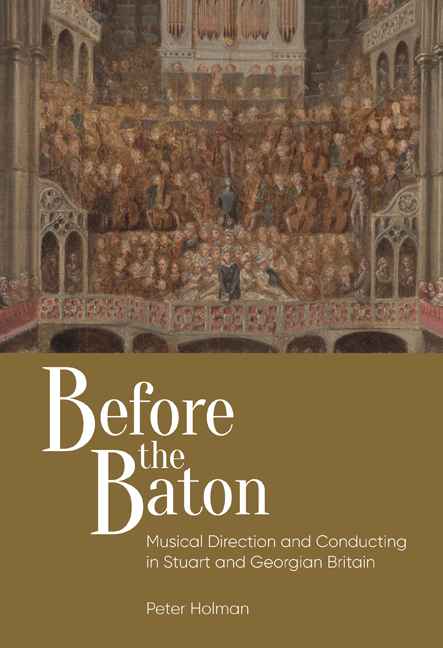Book contents
- Frontmatter
- Dedication
- Contents
- List of Illustrations
- Foreword
- Acknowledgements
- Note to the Reader
- List of Abbreviations
- Prelude To Beat or Not to Beat: The Continental Context
- Part I Directing Choral Music
- Chapter 1 ‘Heard but not Seen’: Leading Anglican Cathedral Music from the Organ
- Chapter 2 ‘With a Scroll of Parchment or Paper, in Hand’: Large- Scale Choral Music
- Chapter 3 ‘Accompanied all along on the Organ by his Own Inimitable Hand’: Handel and the Direction of his Oratorios
- Chapter 4 ‘The Conductor at the Organ’: The Oratorio Tradition after Handel
- Part II Directing Opera and Theatre Music
- Chapter 5 ‘That Ridiculous Custom’: From Devolved Direction to Centralized Time-Beating in Seventeenth-Century Theatre Music
- Chapter 6 ‘Il maestro al cembalo’: Directing Opera and Theatre Music from the Harpsichord
- Chapter 7 ‘A New Discipline and a New Style of Playing’: Directing Opera and Theatre Music from the Violin
- Chapter 8 ‘That Powerful Sovereign, the Conductor’: From the Piano to the Rostrum
- Postlude Superconductors or Semiconductors? Lessons for Today
- Bibliography
- Index
- Miscellaneous Endmatter
Chapter 8 - ‘That Powerful Sovereign, the Conductor’: From the Piano to the Rostrum
Published online by Cambridge University Press: 11 September 2020
- Frontmatter
- Dedication
- Contents
- List of Illustrations
- Foreword
- Acknowledgements
- Note to the Reader
- List of Abbreviations
- Prelude To Beat or Not to Beat: The Continental Context
- Part I Directing Choral Music
- Chapter 1 ‘Heard but not Seen’: Leading Anglican Cathedral Music from the Organ
- Chapter 2 ‘With a Scroll of Parchment or Paper, in Hand’: Large- Scale Choral Music
- Chapter 3 ‘Accompanied all along on the Organ by his Own Inimitable Hand’: Handel and the Direction of his Oratorios
- Chapter 4 ‘The Conductor at the Organ’: The Oratorio Tradition after Handel
- Part II Directing Opera and Theatre Music
- Chapter 5 ‘That Ridiculous Custom’: From Devolved Direction to Centralized Time-Beating in Seventeenth-Century Theatre Music
- Chapter 6 ‘Il maestro al cembalo’: Directing Opera and Theatre Music from the Harpsichord
- Chapter 7 ‘A New Discipline and a New Style of Playing’: Directing Opera and Theatre Music from the Violin
- Chapter 8 ‘That Powerful Sovereign, the Conductor’: From the Piano to the Rostrum
- Postlude Superconductors or Semiconductors? Lessons for Today
- Bibliography
- Index
- Miscellaneous Endmatter
Summary
IN the summer of 1802 the organist and conductor George Smart visited Paris with his father and brother, taking advantage of a lull in the Napoleonic Wars following the Treaty of Amiens. After a visit to the Opéra he wrote: ‘The Orchestra consists of 90. Performers – a Maitre d’Orchestre with a small roll of Wood in the middle of the Orchestra conducts. He stands with the score before him and answers the purposes of the Prompter at our Opera House, they have no Prompter but him’. As Smart implied, conducting with a baton was well established in Paris by 1800. David Charlton has shown that the city was ‘a significant cradle of modern conducting’, contrary to received notions derived from Rousseau and others that a batteur de mesure was used in the Opéra until about 1810 ‘to hammer out the beat for the choruses and dances audibly on the floor, a table, or a music desk’.
Eighteenth-century pictures of French theatres repeatedly show the conductor next to the stage in the middle of the pit, reading a score and beating time with a short stick. As discussed in the Prelude, if audible time-beating was used at all it was to convey the beat to dancers or to a sub-conductor in the wings who could relay it to the chorus. By the late eighteenth century time-beating at the Opéra was undertaken by the maitre de musique rather than the batteur de mesure, and descriptions of Jean-Baptiste Rey, maitre de musique from 1781 to 1810, suggest that he was much more than a time-beater. Jean-François Le Sueur praised him in 1801 as ‘the motor of the whole musical action’ (‘le moteur de toute l’action musicale’), able ‘to guide, hold back, or animate the general ensemble’ (‘de guider, retenir ou animer l’ensemble général’), and by ‘a certain skill in movement which strongly imprints both rhythm and character in every ear, to make it understood where the phrase begins, where it develops, and where it ends’ (‘par une certaine addresse de mouvement qui en imprime fortement le rhythme et le caractère dans toutes les oreilles, de faire sentir où la phrase commence, où la phrase se développe, et où la phrase finit’). In other words, he used his baton to convey rhythmic and melodic nuances in performance in a recognisably modern manner.
- Type
- Chapter
- Information
- Before the BatonMusical Direction and Conducting in Stuart and Georgian Britain, pp. 293 - 346Publisher: Boydell & BrewerPrint publication year: 2020



